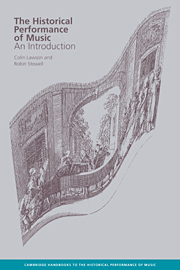4 - Conditions and practices
Published online by Cambridge University Press: 22 September 2009
Summary
Introduction
Throughout history the role and status of musicians have undergone radical changes of emphasis. In the Baroque era employment at court or church was often for life, with changes of position only if an especially tempting offer arose elsewhere. Organists were traditionally the most rigorously trained in matters of musical theory and compositional technique, but the new class of performer involved with instrumental music and opera was also required to extemporise and embellish. Opera singers and (to a lesser extent) instrumental virtuosi began to travel widely and to enjoy great esteem. Meanwhile, chamber music tended to be directed from the keyboard by the composer and was thus characterised by relatively few performance indications. Until around 1700 vocal music enjoyed an almost total supremacy; ensemble sonatas and keyboard toccatas were primarily an adjunct to worship; sinfonias were a preface to opera and oratorio.
During the Classical period ecclesiastical patronage of new music diminished, for economic as well as political reasons. Court and private orchestras also gradually went into decline, though an important outlet for chamber music and smaller-scale pieces remained the private concert. Opera retained its extreme popularity even as the public concert gathered momentum and the symphony increased in size and status. After a lifetime at court, Haydn achieved great success in London in the 1790s as a freelance musician, and this was the model for many of his nineteenth-century successors. Musical priorities after 1800 moved in the direction of the symphony orchestra and music drama.
- Type
- Chapter
- Information
- The Historical Performance of MusicAn Introduction, pp. 83 - 98Publisher: Cambridge University PressPrint publication year: 1999



